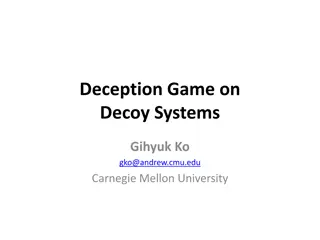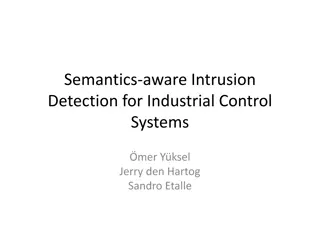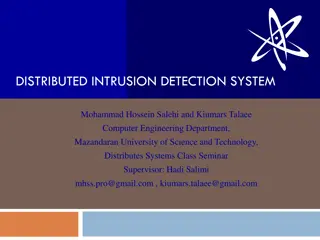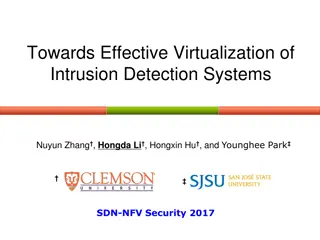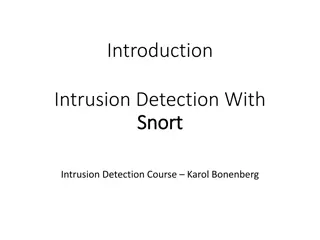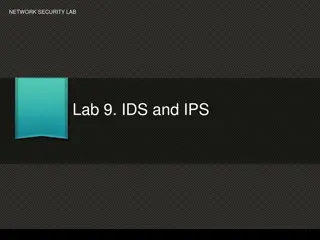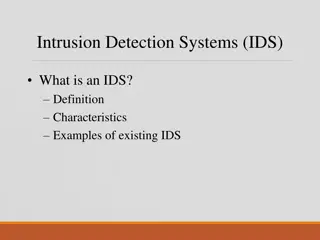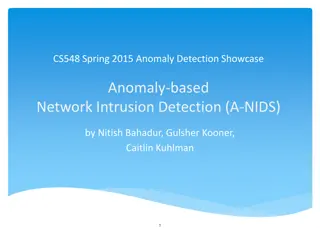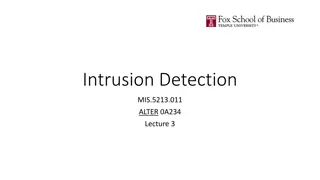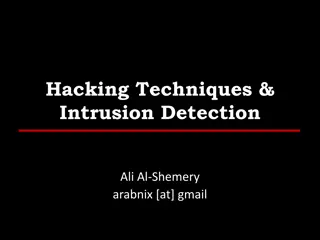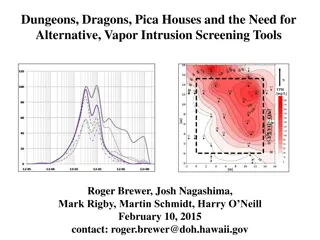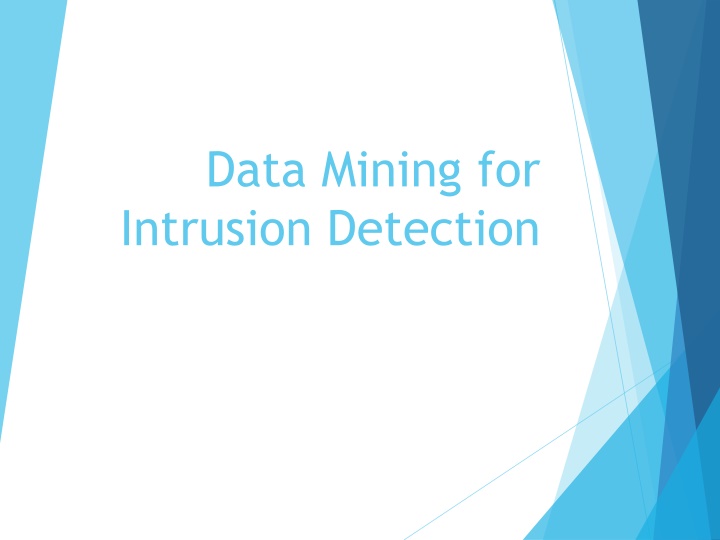
Intrusion Detection in Data Mining
"Explore the importance of protection against cyber threats, incidents of attacks, the anatomy of an intrusion, goals of IDS, intrusion detection approaches, and the workings of an intrusion detection system in data mining."
Download Presentation

Please find below an Image/Link to download the presentation.
The content on the website is provided AS IS for your information and personal use only. It may not be sold, licensed, or shared on other websites without obtaining consent from the author. If you encounter any issues during the download, it is possible that the publisher has removed the file from their server.
You are allowed to download the files provided on this website for personal or commercial use, subject to the condition that they are used lawfully. All files are the property of their respective owners.
The content on the website is provided AS IS for your information and personal use only. It may not be sold, licensed, or shared on other websites without obtaining consent from the author.
E N D
Presentation Transcript
Data Mining for Intrusion Detection
Why do we need protection? Cyberattacks still on rise Threat of cyber-terrorism, more coordinated Even sensitive installations not well-secured, regular breakins Change in demographic: attacks require less sophisticated attackers.
What is an attack? Perspective matters Victim: intrusion of loss or consequence Attacker: achieved specific goals Generally, if the victim has been affected, we say he has been attacked Intrusion: successful attack Even attacker-unsuccessful attempts may be intrusion. (ie Machine crashed)
Breakdown of an Intrusion Intrusion begins when intruder takes steps to fulfill objectives A flaw or weakness must be exploited, either by hand or with a precrafted tool Flaws include social engineering: human processes can weaken security/integrity Intrusion ends when attacker succeeds or gives up. Attacks can have multiple victims or attackers
Goals of IDS Answer the questions: What happened? Who was affected? Who was the attacker? How are they affected? How did the intrusion occur? Where and when did the intrusion originate? Why were we attacked? ID aims to positively identify all attacks and negatively identify all non-attacks
Intrusion Detection Approaches Define and extract the features of behavior in system Define and extract the Rules of Intrusion Apply the rules to detect the intrusion 1. 2. 3. Audit Data 3 2 3 1 Training Audit Data Pattern matching or Classification Features Rules
Thinking about The Intrusion Detection System Intrusion Detection system is a pattern discover and pattern recognition system. The Pattern (Rule) is the most important part in the Intrusion Detection System Pattern(Rule) Expression Pattern(Rule) Discover Pattern Matching & Pattern Recognition.
Machine Learning & Data mining & Statistics methods Training Data & Knowled ge Traning Audit Data Feature Extraction Pattern Extraction Expert Knowledge & Rule collection & Rule abstraction Pattern & Decision Rule Pattern Matching Alarms Intrusion Detection System Real-Time Aduit data Discriminate function Pattern Recognition Pass
Rule Discover Method Expert System Measure Based method Statistical method Information-Theoretic Measures Outlier analysis Discovery Association Rules Classification Cluster
Pattern Matching & Pattern Recognition Methods Pattern Matching State Transition & Automata Analysis Case Based reasoning Expert System Measure Based method Statistical method Information-Theoretic Measures Outlier analysis Association Pattern Machine Learning method
Association Rules Motivated by market-basket analysis Generate Rules that capture implications between attribute values Rule Example Lettuce & Tomato -> Salad Dressing [0.4, 0.9] Parameters [s, c] Support (s) % records satisfy LHS and RHS Confidence (c) = P(satisfies RHS | satisfies LHS) Mining Problem Find all association rules that have support and confidence > user-defined minimum value Data Mining in Intrusion Detection 3/20/2025 12
Association Pattern Discover Goal is to derive multi-feature (attribute) correlations from a set of records. An expression of an association pattern: The Pattern Discover Algorithm: 1. Apriori Algorithm 2. FP(frequent pattern)-Tree
Association Pattern Detecting Statistics Approaches Constructing temporal statistical features from discovered pattern. Using measure-based method to detect intrusion Pattern Matching Nobody discuss this idea.
Classification: A Two-Step Process Model construction: describe a set of predetermined classes Training dataset: tuples for model construction Each tuple/sample belongs to a predefined class Classification rules, decision trees, or math formulae Model application: classify unseen objects Estimate accuracy of the model using an independent test set Acceptable accuracy apply the model to classify data tuples with unknown class labels
Classification Methods Basic Algorithm ID3 Neural networks Bayesian classification Na ve Bayesian classification Bayesian belief network Support vector machines
Classification for Intrusion Detection Misuse detection Classification based on known intrusions Example: Sinclair et al. An application of machine learning to network intrusion detection Use decision trees and ID3 on host session data Use genetic algorithms to generate rules If <pattern> then <alert>
HIDE A hierarchical network intrusion detection system using statistical processing and neural network classification by Zheng et al. Five major components Probes collect traffic data Event preprocessor preprocesses traffic data and feeds the statistical model Statistical processor maintains a model for normal activities and generates vectors for new events Neural network classifies the vectors of new events Post processor generates reports
Intrusion Detection by NN and SVM S. Mukkamala et al., IEEE IJCNN May 2002 Discover useful patterns or features that describe user behavior on a system Use the set of relevant features to build classifiers SVMs have great potential to be used in place of NNs due to its scalability and faster training and running time NNs are especially suited for multi-category classification
A Systematic FrameworkJ.Stolfo et al. Build good models: select appropriate features of audit data to build intrusion detection models Build better models: architect a hierarchical detector system that combines multiple detection models Build updated models: dynamically update and deploy new detection system as needed
A Systematic Framework Support for the feature selection and model construction: Apply data mining algorithms to find consistent inter- and intra- audit record (event) patterns Use the features and time windows in the discovered patterns to build detection models A support environment to semi-automate this process
A Systematic Framework Combining multiple detection models: Each (base) detector model monitors one aspect of the system They can employ different techniques and be independent of each other The learned (meta) detector combines evidence from a number of base detectors An intelligent agent-based architecture: learning agents: continuously compute (learn) the detection models detection agents: use the (updated) models to detect intrusions
Building Classifiers for Intrusion Detection J.Stolfo et al. Experiments in constructing classification models for anomaly detection Two experiments: sendmail system call data network tcpdump data Use meta classifier to combine multiple classification models
Classification Models on sendmail The data: sequence of system calls made by sendmail. Classification models (rules): describe the normal patterns of the system call sequences. The rule set is the normal profile of sendmail Detection: calculate the deviation from the profile large number/high scores of violations to the rules in a new trace suggests an exploit
Classification Models on sendmail The sendmail data: Each trace has two columns: the process ids and the system call numbers Normal traces: sendmail and sendmail daemon Abnormal traces: sunsendmailcap, syslog-remote, syslog- remote, decode, sm5x and sm56a attacks
Classification Models on sendmail Lessons learned: Normal behavior can be established and used to detect anomalous usage Need to collect near complete normal data in order to build the normal model But how do we know when to stop collecting? Need tools to guide the audit data gathering process
Classification Models on tcpdump The tcpdump data (part of a public data visualization contest): Packets of incoming, out-going, and internal broadcast traffic One trace of normal network traffic Three traces of network intrusions
Data Preprocessing Extract the connection level features: Record connection attempts Watch how connection is terminated Each record has: start time and duration participating hosts and ports (applications) statistics (e.g., # of bytes) flag: normal or a connection/termination error protocol: TCP or UDP Divide connections into 3 types: incoming, out-going, and inter-lan
Building Classifier for Each Type of Connections Use the destination service (port) as the class label Training data: 80% of the normal connections Testing data: 20% of the normal connections and connections in the 3 intrusion traces Apply RIPPER to learn rules
Lessons Learned Data preprocessing requires extensive domain knowledge Adding temporal features improves classification accuracy Need tools to guide (temporal) feature selection
Meta Classifier that Combines Evidence from Multiple Detection Models Build base classifiers that each model one aspect of the system The meta learning task: each record has a collection of evidence from base classifiers, and a class label normal or abnormal on the state of the system Apply a learning algorithm to produce the meta classifier
Reference http://www.cs.kent.edu/~jin/dataminingcourse/intrusi ondection.ppt






